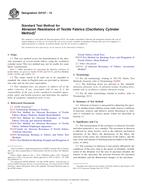Potřebujeme váš souhlas k využití jednotlivých dat, aby se vám mimo jiné mohly ukazovat informace týkající se vašich zájmů. Souhlas udělíte kliknutím na tlačítko „OK“.
ASTM D4157-13
Standard Test Method for Abrasion Resistance of Textile Fabrics (Oscillatory Cylinder Method)
Automaticky přeložený název:
Standardní zkušební metoda pro odolnost proti oděru z textilií (Oscilační metoda Cylinder)
NORMA vydána dne 1.7.2013
Informace o normě:
Označení normy: ASTM D4157-13
Poznámka: NEPLATNÁ
Datum vydání normy: 1.7.2013
Kód zboží: NS-26258
Počet stran: 7
Přibližná hmotnost: 21 g (0.05 liber)
Země: Americká technická norma
Kategorie: Technické normy ASTM
Kategorie - podobné normy:
Anotace textu normy ASTM D4157-13 :
Keywords:
abrasion, woven fabric, ICS Number Code 59.080.30 (Textile fabrics)
Doplňující informace
| Significance and Use | ||||||||||||||||||
|
5.1 The measurement of the resistance to abrasion of textile and other materials is very complex. The resistance to abrasion is affected by many factors, such as the inherent mechanical properties of the fibers; the dimensions of the fibers; the structure of the yarns; the construction of the fabrics; and the type, kind, and amount of finishing material added to the fibers, yarns, or fabric. 5.2 The resistance to abrasion is also greatly affected by the conditions of the tests, such as the nature of abradant; variable action of the abradant over the area of specimen abraded, the tension of the specimen, the pressure between the specimen and abradant, and the dimensional changes in the specimen. 5.3 Abrasion tests are all subject to variation due to changes in the abradant during specific tests. The abradant must accordingly be changed at frequent intervals or checked periodically against a standard. With disposable abradants, the abradant is used only once or changed after limited use. With permanent abradants that use hardened metal or equivalent surfaces, it is assumed that the abradant will not change appreciably in a specific series of tests, but obviously similar abradants used in different laboratories will not likely change at the same rate due to differences in usage. Permanent abradants may also change due to pick up of finishing or other material from test fabrics and must accordingly be cleaned at frequent intervals. The measurement of the relative amount of abrasion may also be affected by the method of evaluation and may be influenced by the judgment of the operator. 5.4 The resistance of textile materials to abrasion as measured on a testing machine in the laboratory is generally only one of several factors contributing to wear performance or durability as experienced in the actual use of the material. While “abrasion resistance” (often stated in terms of the number of cycles on a specified machine, using a specified technique to produce a specified degree or amount of abrasion) and “durability” (defined as the ability to withstand deterioration or wearing out in use, including the effects of abrasion) are frequently related, the relationship varies with different end uses, and different factors may be necessary in any calculation of predicted durability from specific abrasion data. Laboratory tests may be reliable as an indication of relative end-use performance in cases where the difference in abrasion resistance of various materials is large, but they should not be relied upon where differences in laboratory test findings are small. In general, they should not be relied upon for prediction of actual wear-life in specific end uses unless there are data showing the specific relationship between laboratory abrasion tests and actual wear in the intended end-use. 5.5 These general observations apply to all types of fabrics, including woven, nonwoven, and knit apparel fabrics, household fabrics, industrial fabrics, and floor coverings. It is not surprising, therefore, to find that there are many different types of abrasion testing machines, abradants, testing conditions, testing procedures, methods of evaluation of abrasion resistance, and interpretation of results. 5.6 All the test methods and instruments so far developed for abrasion resistance may show a high degree of variability in results obtained by different operators and in different laboratories; however, they represent the methods now most widely in use. This test method provides a comparative measurement of the resistance of woven textile fabrics to abrasion, and may not necessarily predict the actyal performance of fabrics in actual use. 5.7 If there are differences of practical significance between reported test results for two or more laboratories, comparative tests should be performed to determine if there is a statistical bias between them, using competent statistical assistance. As a minimum, test samples that are as homogeneous as possible, drawn from the material from which the disparate test results were obtained, and randomly assigned in equal numbers to each laboratory for testing. The test results from the two laboratories should be compared using a statistical test for unpaired data, at a probability level chosen prior to the testing series. If bias is found, either its cause must be found and corrected, or future test results must be adjusted in consideration of the known bias. |
||||||||||||||||||
| 1. Scope | ||||||||||||||||||
|
1.1 This test method covers the determination of the abrasion resistance of woven textile fabrics using the oscillatory cylinder tester. This test method may not be usable for some fabric constructions. 1.2 The values stated in SI units
are to be regarded as standard; the values in English units are
provided as information only and are not exact equivalents.
1.3 This standard does not purport to address all of the safety concerns, if any, associated with its use. It is the responsibility of the user of this standard to establish appropriate safety and health practices and determine the applicability of regulatory limitations prior to use. |
||||||||||||||||||
| 2. Referenced Documents | ||||||||||||||||||
|
Odebírejte informace o nově vydaných normách ZDARMA:
Chcete pravidelně odebírat informace o nově vycházejících normách z celého světa a to zcela zdarma?
Přihlašte se k odběru. Vše je velice jednoduché a absolutně ZDARMA.
Na výběr máte vydavatele z celého světa.




 Cookies
Cookies
